The temples, ruins and historic sites around Luxor are the most spectacular parts of visiting Ancient Egypt. That’s right. Even when considering the Pyramids and the Great Sphinx in Giza, nothing from Ancient Egypt comes close to Luxor Temple, the Valley of the Kings and the Karnak Temple Complex.
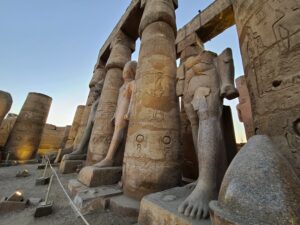
The Pyramids are huge and extremely famous. They are absolutely interesting, and visiting them is an unforgettable experience, but the sites of Ancient Egypt in and around Luxor are on a different level.
For those unaware, Upper Egypt is actually Southern Egypt. “Upper” refers to the direction of the northerly-flowing Nile River, this area of Egypt being UPstream on the Nile.
The ruins of long-time ancient capital Thebes (Waset to ancient Egyptians) lie on the banks of the Nile within present-day Luxor, the largest city in Southern/Upper Egypt. It is a fairly densely populated city with a little less than 1.5 million people. For comparison, the density is only slightly less than Cairo, which is one of the largest, most densely populated areas in the world.
In other words, the city of Luxor, while crowded, does not cover a very large area. As always, life in Egypt is close to the river. For most visitors, their time will be spent in areas near the Nile River. Most hotels are close to the river, and the temple complexes of Luxor and Karnak are right there.
Before we get to it, this is a travel blog to share stories, information and tips. We are not a travel agency, nor are we a tour service. I understand what it’s like trying to search for travel information about the famous sites of Ancient Egypt. Navigating through the dozens of pages and websites that are ultimately selling tours and excursions is frustrating. It’s difficult to know what is authentic and trustworthy. All of the information here is based on our own research and our personal experiences at Luxor Temple, Karnak and the Valley of the Kings.
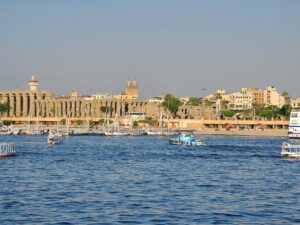
Contents
Luxor Temple
Luxor Temple is right next to the Nile River. It is literally across the street. For the many visitors who reach Luxor via river cruise, most of the ships dock right there, within steps of the temple.
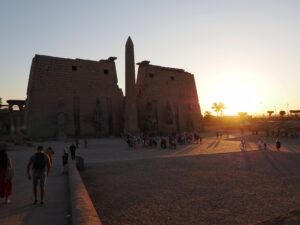
Luxor Temple Complex is over 3000 years old, initially constructed during the reign of Amenhotep the Great and expanded over thousands of years. Even King Tut left his mark on the complex. And, of course, the structures were utilized by the Greeks and Romans when they conquered Egypt.
The history of Luxor Temple is long, intertwining several empires, and it’s fascinating. Such an abundance of history can be overwhelming, though. It’s impractical for most visitors to travel to Egypt and absorb all of the information. Truthfully, most visitors grow numb to the inundation of facts, tales and legends. Realistically, people devote their entire lives to the history in this region and can’t learn and discover everything.
Others may simply not be interested. I’m not of the same mind, but that’s okay. How one enjoys their trip isn’t really my concern. Except for the wannabe-influencer photo shoots – that is thoroughly cringeworthy and annoying.
Anyway, the best way to approach your visit to Luxor Temple (and other places) is simply to enjoy it. Don’t stress about learning and seeing everything. It’s not disrespectful. It’s practical. Factoring in the abundance of information, the stress of aggressive touts and the oppressive Egyptian heat, it can be exhausting. Just have fun.
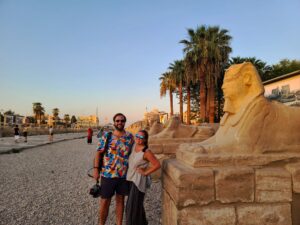
Luxor Temple sits in the heart of Luxor. It’s not especially large and is fairly well-preserved. It does get crowded when the cruise ships unload their passengers, especially at night. The best way to enjoy the temple is with patience. We all want photos of the site, and it can be frustrating when so many people find their way into every shot.
What I appreciate about Luxor Temple is how close it is to the Nile River. The setting is picturesque, to say the least, with famous ancient ruins situated on the banks of the very river that has provided sustenance to nearby residents for thousands of years. The Nile River is the lifeblood of Egypt, and Luxor Temple’s location highlights that.
The late afternoon sun highlights the temple in the best way. Make sure to enjoy the scene during one of Egypt’s spectacular sunsets.
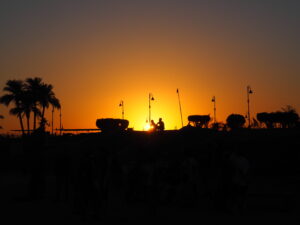
Even more remarkable is that Luxor Temple has survived for so long. To stroll through the temple and marvel at the architecture, artistry and resilience of the structure is impressive. Glancing in one direction and seeing one of the world’s most important and powerful rivers a stone’s throw away furthers the notion of the temple’s resilience.
Rivers like the Nile provide, but they are also extremely powerful. The dry weather in Egypt is known for preserving the ancient, but one might assume that the power of the Nile River would have a negative effect. However, evidence suggests that many ancient sites were actually protected by the river.
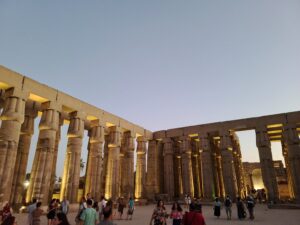
Seasonal floods came and deposited silt, which often buried and sealed off remnants of the ancient world for long periods of time. When sites were fully excavated, it became apparent that the harsh elements, including the water of the Nile, acted as preservatives. Thankfully, many of these spectacular pieces of human culture and history were found at the right times and cared for appropriately.
Avenue of Sphinxes
One of the most spectacular sights in Egypt is the Avenue of Sphinxes. An ancient avenue that connects Luxor and Karnak, nearly two miles long, the entire path is lined with statues on either side.
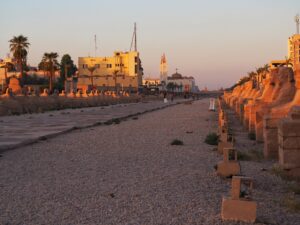
Some of the statues are rams, and others are criosphinx, which is a combination of a lion’s body with a ram’s head. The majority are the familiar sphinx, a lion’s body with a human head.
These are not the grandest statues. Compared to the famous Great Sphinx in Giza, they are quite small, but the sight is awesome. That is not to say these are miniature sphinxes. Each one is solid stone, over 6 feet tall and more than 12 feet long.
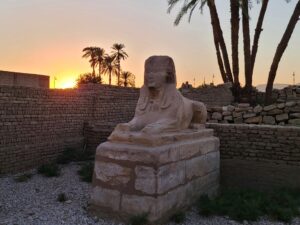
There are 1057 sphinxes, criosphinxes and rams in total.
Let’s put that into perspective. Thousands of years ago, in a time without mechanical power or tools, Ancient Egyptians extracted literal tons of stone, transported it to present-day Luxor and carved it into a perfect statue. And then did this 1056 more times. Each style of statue is identical and perfectly spaced from one another in a straight line nearly two miles long.
That is an incredible feat of engineering and craftsmanship. And it’s merely the road that connects two large temples, each imposing and magnificent in its own right.
While some of the statues were known and visible in recent history, the entire road between Luxor and Karnak was not completely excavated and open until 2021.
This is a great example of a massive piece of ancient history that has only recently been fully realized, and this is precisely why many people find Egypt an interesting place to visit. From an historic and touristic standpoint, it is constantly changing and developing. It is certainly not a “one and done” destination where you can check off all the boxes in a single trip.
The Avenue of Sphinxes, thousands of years old, stretching for such a great distance is not only an incredible feat of engineering. Perhaps the most extraordinary aspect is that it has survived so long. With the decline of Ancient Egypt, the road was gradually covered in sand. Lucky for us, the elements of nature and the course of history have preserved this stunning archaeological site.
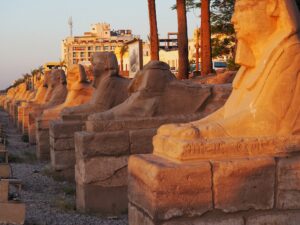
One of the things I wish to do the most upon my return to Egypt is walk the entire length of the Avenue of the Sphinxes. At the time of my visit, the heat was taking its toll and time was limited. If you are able to walk the entire length, do it.
Karnak Temple Complex
At the other end of the Avenue of Sphinxes, opposite of Luxor Temple, is the Karnak Temple Complex. Approximately two miles away, Karnak is an enormous site.

Karnak is approximately 250 astounding acres of history. And, honestly, it’s hardly reasonable for the average tourist to absorb even a fraction of the history here. This is partially due to the scale of the site, but also because, from our current perspective, we view this as a single ancient site. What we view through our current lens of time as an individual ancient complex is, more accurately, the remains of several temples, monuments and shrines that were constructed during the reigns of several generations of pharaohs over many centuries.
The oldest portion of Karnak dates back almost 4000 years. Most of the site is at least 3000 years old, though there are some “newer” additions a mere 2000 years old.
There are many remarkable sights at Karnak. There are several ancient temples, varying from shockingly well-preserved to thoroughly ruined. One of the largest surviving obelisks of the ancient world is also found at Karnak. There is a sacred lake, which I am, admittedly, ignorant of its precise significance.

Adjacent to the lake is a statue of a scarab, the famous dung beetle of Ancient Egypt. The importance of this particular statue remains a mystery to me, but it can easily be found. There are people walking around it in circles, hoping that, after 7 revolutions, their greatest wish will come true.
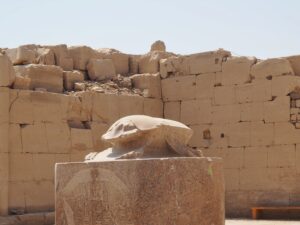
Like Luxor Temple, Karnak sits with direct access to the Nile River. The large, open promenade between the river and the complex leads to a large pylon (the large entrance/facade of a temple complex). The entrance is lined with more small sphinxes and rams and opens into an open space like a big courtyard. The perimeter is lined with columns and statues and would be a cool sight in its own right. Beyond this area is one of the most spectacular remnants of Ancient Egypt.
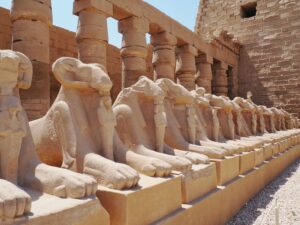
The Great Hypostyle Hall
The Great Hypostyle Hall is a jaw-dropping sight to witness. What must have been the centerpiece of the Karnak Temple Complex is a collection of massive ancient columns spread across more than 50,000 square feet of area. The pillars are huge, some more than 30 feet in circumference and 70 feet tall. The columns vary in size, but the larger ones weigh 100 tons. For reference, a single column weighs more than multiple school buses.

Beyond the magnitude, the intricate detail and the beauty of the Great Hypostyle Hall is the mind-blowing engineering feat required to construct it. It would be easy to spend hours sitting there, pondering how it came together. The columns themselves are obviously massive, heavy objects. And there are a lot of them, 134 in total. How they managed to extract the stone, transport it, shape and raise these columns – by the way, they did it so precisely that they have lasted over 3000 years – with minimal tools and nothing but manpower and animals, it’s difficult to comprehend.
This, in itself, is an incogitable accomplishment. However, it’s not only the design and erection of over 100 gigantic columns that piques one’s curiosity and amazement. Originally, the Great Hypostyle Hall had a roof. This has not survived, but the beams that supported the roof have. The beams weigh a staggering 140,000 pounds, over 70 tons.

How exactly the Great Hypostyle Hall was constructed is a matter of debate for scholars and archaeologists. There are theories involving levers and ramps, among other hypotheses. The truth may lie somewhere in the debate, but I can be certain that this was an enormous task. Loading, raising and balancing massive columns and beams in place so perfectly that they can withstand thousands of years of nature and human life – the difficulty of this project cannot be overstated.
Each column is also covered in inscriptions that detail accounts of important historical events regarding the pharaohs who oversaw the construction. Many of these inscriptions have survived. For historians, this is a treasure trove of information. For the layman, the scene is an ancient work of art. When I inquired why they repainted some of the scenes on the columns and not all of them, I was quickly informed that this was, in fact, the original paint.

That tiny fact struck me. In addition to the structures and inscriptions, even the paint surviving – through times of war, conquest and the ever-present harsh desert environment – wow!
As I stared upward, likely with a slack jaw and perplexion visible on my face, I could not help but let my mind wonder about it all. With contemporary knowledge of science, would we be able to recreate the structure today without modern mechanical tools? Even three millenia later, it would assuredly be an impressive achievement.
Karnak is a magnificent piece of ancient history. Although it is certainly not forgotten, this complex deserves more attention than it receives.
Valley of the Kings
The Valley of the Kings is one of the most famous ancient sites in the world. In the frame of Ancient Egypt, it is nearly as famous as the Pyramids of Giza and the Great Sphinx.
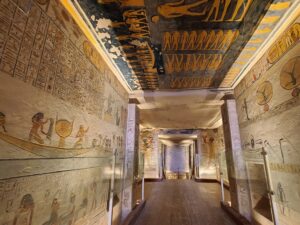
Much of the notoriety of the Valley of the Kings is due to the 1922 discovery of the tomb of Tutankhamen. King Tut’s tomb, which was found nearly intact and barely disturbed (looted) in the more than 3000 years since his death, showed the world a glimpse into the immense wealth of Ancient Egypt’s pharaohs.
Compound the now-visible wealth of Ancient Egyptian Royalty with the fact that King Tut was, in the grand scheme of Ancient Egypt, a rather minor pharaoh, imaginations began to run wild. Interest in Ancient Egypt grew immensely. If this guy was not a major historical figure, more significant pharaohs must have had incomprehensible riches in their tombs.
Then there is the belief that there may be more tombs yet to be discovered. Egypt has a long history. There were a lot of rich, powerful people who died and didn’t want to part with their worldly possessions. What else might remain hidden?
Oh, and there are plenty of peculiar deaths and supposed curses associated with digging up these ancient sites.
All of this factored into the Valley of the Kings achieving notoriety as a fascinating and mysterious site. Naturally, as travel to distant places has become easier over the last century, the Valley of the Kings has become a popular stop on tours of Egypt.
The reality of visiting the Valley of the Kings as a tourist isn’t quite as exciting as all of the history and mystery, but it is one of the most wondrous archaeological sites in Egypt. In a land with thousands of years of visible, documented history, that is saying a lot.
So what exactly is the Valley of the Kings?
Essentially, it’s a small area within the larger Thebes necropolis (burial site) for royalty and nobility. The necropolis also includes the Valley of the Queens and the Mortuary Temple of Hatshepsut, among other historic sites.
For over 400 years, Egyptian kings, queens, their families and some members of the nobility were buried in elaborate tombs in the area. Generally speaking, the tombs date back approximately 3000-3500 years ago.
The Valley of the Kings is little more than a wadi, an area where rainfall collects, drains and erodes the landscape over time. It appears like a small canyon but lacks any permanent presence of water. And rain in this area is extremely rare. At the time of my visit, Luxor had not had a drop of rain in 10 years!
Frankly, if one were walking through the area, tomb entrances undiscovered and not yet visible, there is nothing to see. It is a rugged, harsh area. Pure desert. You’re surrounded by rocks, dirt and sun. Forget about greenery, shade or water.
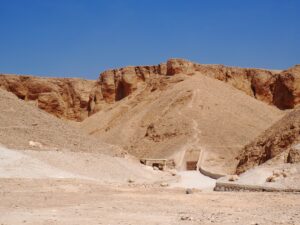
Thankfully, this is not the case. The area has been explored and excavated. Aside from the tombs, there is still nothing around, but what lies beneath the surface more than makes up for the barren landscape.
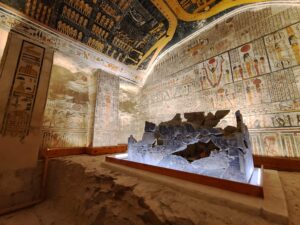
In total, there are currently 65 tombs at the Valley of the Kings. “Currently” is the key word here. Multiple tombs have been discovered in the 21st Century, and records from 1500 BC are probably not the most reliable or extant sources. Archaeologists are still exploring, searching and excavating the area, so it’s entirely possible further fantastic discoveries are in the future.
The treasures and mummies that once rested in tombs of the Valley of the Kings have long been stolen, lost or relocated to museums. As unfortunate as this is, what was left behind may be even more monumental than gold and jewels.
Don’t let the unassuming entrances deceive you. For starters, these aren’t small crypts. The largest known tomb is that of Rameses II. It has 120 known rooms. Unfortunately, it is still being excavated and isn’t open to the public. Another notably large tomb is the tomb of Rameses III, which is open and is over 600 feet long. The tombs aren’t small, so hopefully this helps provide some comfort for curious claustrophobes.
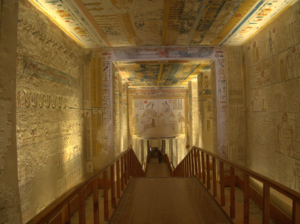
Once inside, the tombs are decorated from wall to wall, ceiling to floor. They are designed with reliefs, paintings, hieroglyphics and art that tells stories and history. The vivid colors inside the tombs are the original, 3000-year-old strokes of paint.
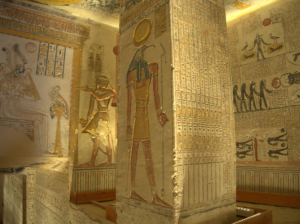
The Valley of the Kings is sort of like a collection of dozens of adjacent subterranean ancient art galleries, each unique with its own history and tales. There is truly no place in the world like it. The idea of tiny, dusty old tombs is far from reality, and seeing these pieces of history up close is one of the coolest things you can do in Egypt.

What’s So Special about the Sites in Upper Egypt?
Why is Upper Egypt a more interesting place to visit than the Pyramids, Sphinx and everything around the complex in Giza?
There are several reasons. Here are a few:
Ancient Upper Egypt is in Better Shape
In my opinion, the archaeological sites in Upper Egypt are in much better condition. There are definitely areas that fully qualify as ruins, but preservation and restoration is much more apparent.
To be clear, this is not limited to the area around ancient Thebes and modern-day Luxor. Aswan, Edfu, Kom Ombo, Abu Simbel, Esna and more – many cities and towns along the Nile in Upper Egypt are home to remarkable pieces of history.
There are a couple of obvious reasons for this. Lower Egypt, i.e. Cairo and Alexandria, has been far more developed since ancient times. Growing populations and urban areas naturally sacrifice marks of antiquity. They are demolished or concealed through urban growth. Crucially important agricultural endeavors take priority.
Another impact of geography is that Lower Egypt is much closer and more accessible to conquering empires throughout history. Armies and civilizations spent less time hundreds of miles south when the need wasn’t there.
The Pyramids are an excellent example. Nearly the entire once-bright-and-shiny facade of the Great Pyramid was dismantled to build the medieval citadel of Cairo and other projects. Many ancient structures and cities in southern Egypt were largely spared this level of destruction. There are exceptions, of course; and to see these exceptions in person (much to the indignation of Egyptians), all you have to do is visit places like Rome, New York City, London or Istanbul to witness spectacular monuments of Ancient Egypt withering away in the middle of modern cities.
The Pyramids are also older. That, undeniably, makes them even more impressive, but time takes its toll and erodes the details.
There is also more substance surrounding sites of Ancient Egypt like Luxor, Karnak and the Valley of the Kings. This, in part, is due to all of the aforementioned effects that impacted the ruins up north. However, in my opinion, the artistry and craftsmanship that is visible in the temples, tombs and other archaeological sites in Upper Egypt is more impressive today.
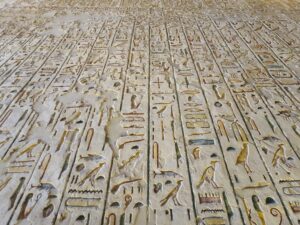
To be fair, some of the famous sites have been restored to the point where they aren’t ancient at all. For instance, large portions of the Mortuary Temple of Hatshepsut (seen below), which is more famous in the 21st Century for hosting fashion shows, aren’t all that ancient. The temple is still beautiful, and there are ancient parts, but, personally, I’m not fond of over-restoration.
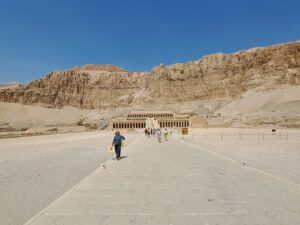
None of this is to suggest that the Pyramids are not worth seeing. They are. Rather, I find the visibly-preserved detail at sites around Luxor to be extraordinary. And it’s still extremely old.
Smaller Crowds
The historic sites and attractions in Upper Egypt are generally much less crowded than those in the Cairo/Giza area. The crowd sizes in Upper Egypt vary slightly based on the time of year and the time of day, but the Pyramids never really have a down time. Understandably so, the whole area is pretty much always busy. From open to close.
Generally speaking, when the cruise ships dock, sites in Upper Egypt get busy. For example, Edfu Temple is located in the small city of Edfu. The densely populated city is extremely impoverished. The ancient temple is the only point of interest, and the city is virtually devoid of tourists except in the brief hours when the river-cruising tourists descend upon Edfu. When the boats aren’t there, you can explore Edfu nearly to yourself.
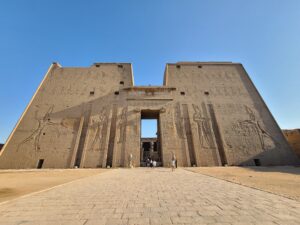
Side note: This is a perfect example of how cruise tourism barely helps the communities in which ships dock. Despite the fact that thousands of tourists visit Edfu Temple each day, there are only a handful of hotels in the city of 60,000 people, and most of these would scare away the typical tourist. Aside from the souvenir stalls at the temple, there aren’t even any tourist shops. No tourist-focused restaurants. Cruises dock. Passengers unload and take a horse-drawn buggy through the dusty streets and straight to the temple. After touring the temple, they go right back. It is abundantly clear that the city and people of Edfu see little, if any, benefit from this.
Anyway, the point of mentioning the river cruises docking in Edfu is to demonstrate that if you want to avoid crowds at temples along the Nile, the opportunities are there. This principle can be applied to Luxor Temple and Karnak as well, though to a lesser degree.
The seasonal flux of tourist arrivals is also more noticeable in Upper Egypt. Temperatures are even hotter down south, thus thinning the crowds slightly during Summer months.
Another Side of Egypt
The Pyramids receive nearly 10 times the annual amount of visitors than Valley of the Kings, over 14 million compared to about 1.5 million.
Located adjacent to Cairo and much closer to Europe, a trip to the Pyramids isn’t a long trek for many tourists, whereas venturing a few hundred miles south requires significantly more time. Cairo is a fascinating megacity, and I would encourage any curious traveler to visit, but that is only one side of Egypt.
Even from the confines of a river cruise or site-hopping from one ancient site to another, it’s inevitable that a trip to the archaeological sites around Luxor, Aswan or somewhere in between will present a different side of Egypt to a traveler. Seeing more of a destination is worthwhile and, in my opinion, a very important part of travel.
England is more than London. Japan, more than Tokyo. The USA, more than New York City. And Egypt is certainly more than Cairo. Traveling to and through areas that aren’t the holiday objective helps us to understand the history better. Even brief glimpses of areas outside of our tourist bubbles provide an excellent way to better understand a people and their nation today.
On top of all this, Upper Egypt has some of the most fantastic sunsets I’ve ever seen. The desolate landscapes are beautiful. It’s worth the extra time.
When and How Long?
How much time do you need to visit Karnak, Luxor Temple and the Valley of the Kings?
This question can be answered simply: As much time as you can stand.
It would be easy to spend an entire day at each of these famous sites. The length of time you should spend at each comes down almost entirely to the heat and your tolerance of oppressive temperatures.
Egypt is extremely hot. Upper Egypt is hotter than most other areas. As mentioned above, you can forget about rain, and cloud cover is also uncommon. The desert sun here is relentless.
Luxor Temple
Visiting Luxor Temple doesn’t require as much time. It is the smallest of the major sites in the area. You can rush through in less than an hour, or you can spend 2-3 hours leisurely working your way through. Much of this depends on the time of day.
When it’s busier, it can take longer to see particular parts of the temple and get the photos you want. On the other hand, you can enjoy it further without the crowds.
Dusk is the most popular time to visit Luxor Temple. Temperatures are growing more pleasant, and this is when many of the river cruises dock and release their passengers. It is crowded after dark, but the temple illuminated by lights is a pretty spectacular scene.

If you want to avoid the crowds, I suggest visiting Luxor Temple during the daytime. It can be extremely hot, so make sure you are prepared, but the heat creates noticeably sparser crowds. The complex isn’t that large and is centrally located, making it a little easier to seek relief from the sun before and after your visit.
A morning visit may be a reasonable compromise. Keep in mind that mornings are still hot, and it will be busier than later in the day.
Karnak
As long as you can stand. This site is astonishing, but there are few areas that offer protection from the sun. Even the on-site museum is hot. It is indoors and has air conditioning, but it was hardly noticeable.
Heat aside, I suggest spending as much time at Karnak as you can. This is truly a remarkable place. The size alone warrants a fair amount of time. The added history, beauty and constant wow-factor around each corner only calls for more time.
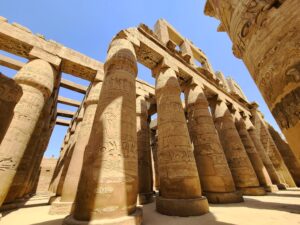
Realistically, a few hours is more than enough time to visit Karnak for your first visit. Weather aside, it’s a lot to absorb. In 2-4 hours, you can learn a lot, appreciate the achievement, take more than enough photos and still manage to conserve enough energy to function.
Valley of the Kings
The temperature was 114°F (45.6°C) the day we visited. That’s extremely hot. You might think that entering the tombs, underground and sheltered from the sun, would offer a pleasant respite. To my surprise, the tombs are even hotter. There is virtually no ventilation, so the air is heavy. Naturally, we were already a little sweaty when we reached the entrance to the first tomb. Within 30 seconds of entering, my clothes were completely soaked and sweat was dripping from every pore on my body. Exiting the tombs back to the 114°F air somehow felt refreshing.
When the tour buses arrive and thousands of people descend upon the tombs, the air within grows more unpleasant. It is really saying something that it is more comfortable when you step outside into the extreme heat of the Sahara.
With that in mind, it is crucial to arrive at the Valley of the Kings as early as possible. Not only will the temperatures outside be slightly cooler, the interior heat of the tombs will be slightly more manageable. On top of that, you will likely have many of the tombs all to yourself.
We arrived early and were able to explore the tombs without ever having to wait in a line and rarely having to wait for people to move for the best photos.
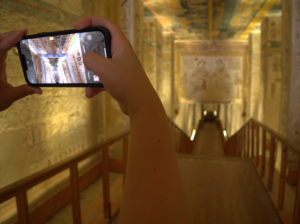
It would be easy to spend days at the Valley of the Kings and wander through the many tombs. Unfortunately, there are usually only 7 (sometimes 8) tombs open at any given time. This is to ensure that tombs don’t see too much foot traffic which, inevitably, affects the structures. It also allows time for the closed tombs to be cared for – cleaned, restored, studied and whatever else that might entail.
Since you are only allowed to visit 3 tombs with a general ticket and a maximum of 7 tombs total, you can only spend so much time at the Valley of the Kings. Factor in the heat and the crowds that come and go throughout the day, a few hours will be sufficient for most people to visit. If you’re determined to see as much as possible, you could more leisurely explore the tombs and simply take breaks between each. The ‘cafe’ on site has shade, fans and cold beverages.
Costs
Depending on your method of travel, tickets will be the primary expense to visit Luxor Temple, the Karnak Temple Complex and the Valley of the Kings. The variance in costs factors in when considering transportation and guides.
Note: A ticket to either Karnak or Luxor Temple should allow you to walk the length of the Avenue of Sphinxes. Also, some sites may offer student discounts. Bring your student ID if you have one.
Luxor Temple
Luxor Temple is the easiest of these Ancient Egyptian archaeological sites to visit in the area. It’s location is within easy walking distance of most accommodation, and it is centrally located.
Tickets to enter Luxor Temple are £260 EGP, about $5 USD, for foreigners. A guided tour will cost extra.
Karnak
Karnak Temple Complex can be reached on foot for free. It isn’t as centrally located as Luxor Temple, but it’s not far. This depends on whether or not you want to walk the distance in the heat.
You can cheaply get a taxi to Karnak from anywhere in Luxor. The trip will only be a few minutes and cost a few dollars at most.
Tickets to Karnak cost £360 EGP, about $7 USD, for foreigners. A guided tour will cost extra.
Valley of the Kings
For the Valley of the Kings, most visitors arrive as part of larger groups. This is evident based on the number of tour buses in the parking lot. Others hire private guides, while some choose to visit independently.
General tickets to visit 3 of the 7 open tombs typically cost around $10 USD. The Egyptian Pound has been fluctuating and unpredictable in recent months, so it’s difficult to state the price with any lasting accuracy. That said, general tickets cost £600 EGP (~$12 USD at time of writing).
That’s a great deal! But, as one learns to anticipate in Egypt, it’s not the whole story.
For starters, your main transportation is only allowed to take you to the parking lot. Beyond the ticket checkpoint to the tombs is a distance of about one-half mile, and there is a shuttle that takes visitors to the tombs. You can walk if you want (I think, but I didn’t see anyone walking). It’s Egypt, so the shuttle is not included in the ticket price, but it’s less than $1 USD per person. And that half mile walk would be in the heat, dust and not flat. Save time and pay for the shuttle.
Again, this is Egypt. The costs don’t end there!
The general ticket includes admission to certain tombs. If you want to visit the tomb of King Tut or one of the more elaborate tombs, such as the combined tomb of Rameses V and Rameses VI (tomb KV9), there is an additional fee. Additional fees only amount to an extra few dollars.
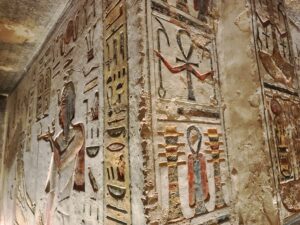
My sincere advice is pay the extra fees. Even if you wind up spending $25 on entrance fees, that’s a great price to visit this wonderful site.
Overall, tickets to Valley of the Kings (including the shuttle and add-ons) should be about $20-25 USD.
Most large tour groups will handle your tickets. All you have to do is follow along.
For those visiting with a private guide, bear in mind that tour guides are not allowed to accompany you into the tombs. Most of them will give you some information, point you in the correct direction and head for the on-site cafe for shade, tea and a smoke, leaving you free to explore the tombs.
If you’ve hired a guide for a single day, you will still be expected to tip them. If your guide is leading you over a longer period, you can wait until the end of your trip to tip.
Independent travelers will have to join a small group tour or find a taxi. Taxis can be easily found in Luxor. Uber is great in Egypt and extremely cheap. However, it’s probably best to hire a taxi given that it’s unlikely you’ll have reception or WiFi at the Valley of the Kings for a return Uber. Taxis will cost you about $10-15 USD each way, or you can pay for the day. You should be able to hire a taxi for the trip there, to wait for you and take you back for NO MORE than $30 USD.
Hotels in Luxor
Many tourists reach Luxor via Nile River Cruise. If this is the case for you, there may not be a need to book a hotel in Luxor. If you are spending an extra day in Luxor before or after your cruise, there are plenty of hotels from which to choose. These vary from cheap, family-run guesthouses to extravagant resorts.
My inclination is to suggest staying close to Luxor Temple. That said, transportation (discussed further below) is plentiful and inexpensive. Perhaps Luxor is a great opportunity to stay in a fancy hotel for a great price. In particular, the Sofitel Winter Palace, an historic hotel overlooking Luxor Temple, looks like an excellent place to splurge for a couple of nights. In hindsight, I wish we stayed a couple of extra nights here.
Luxor Transportation
Local Transportation
For those traveling in large groups or with a private guide, you won’t have to worry much, if at all, about transportation in Luxor. This will all be handled for you.
For independent travelers, getting around the city will be more exciting. You’ll get to see more and figure things out for yourself. Personally, I love this part of travel. Getting around Luxor, if you’re going farther than your feet can take you, will be cheap. Taxis are cheap and abundant. Just make sure to confirm any price before you get into the cab. Uber is also cheap, and it’s easy. Oh, and don’t forget to tip.
Long Distance Transportation
Reaching Luxor from other places in Egypt is fairly simple. You can reach the city via bus from Aswan, Cairo, Hurghada and probably everywhere in between. Buses in Egypt are hit-or-miss in terms of comfort and reliable travel times, so I would suggest avoiding them when possible.
An alternative to the bus is the train. You can take the Night Train from Cairo or Aswan. It’s comfortable and straightforward.
Lastly, flying is also an option. Flights to Luxor from Cairo are about an hour in length and tickets (one-way or round trip) are almost always less than $100. You can fly to Luxor from other locations in Egypt, though regular flights are not always direct, frequently requiring a layover in Cairo. In these instances, it may be wise to consider alternatives.
Luxor International Airport also has flights to Europe around the year. In the cooler months, the airport sees an increase in seasonal flights from many cities in Europe.
Extra Tips for Luxor, Karnak & the Valley of the Kings
- Eat breakfast, this is important. Don’t stuff yourself. That would be foolish. Intense heat makes many of us not want to eat, but a little something like toast, an egg and some fruit can seriously help dealing with the heat later. Also, it might be best to avoid any significant boozing the night before desert sightseeing. These are not the conditions in which you want to be hungover.
- Drink plenty of water. Don’t be afraid to stop for a break in the shade. Have a popsicle. Touring an ancient ruin is never worth risking your health, and everyone is different. My wife has spent most of her life in a place where the average temperature is around 55°F (13°C), whereas I’m from a place that is miserably hot and humid a majority of the year. The heat in Egypt had much less effect on me than my wife, and there were times where she was pleased to rest in the shade while I wandered off to try to see it all. We were both happy and survived. That’s what matters. Don’t overdo it.
- Skip King Tut’s tomb. Yeah, it’s King Tut, I know. He’s the most internationally famous pharaoh today. The discovery of the treasures in his tombs is beyond famous – it’s legend! Unfortunately for the Valley of the Kings and people of Luxor, the bulk of the priceless cache of riches found in Tut’s tomb is housed in the Grand Egyptian Museum. Hundreds of miles away in Giza. His tomb itself wasn’t meant for a pharaoh. His sudden death and rushed burial prevented this. Essentially, Tutankhamen didn’t have years to plan and design an ornate tomb like some of the others at the Valley of the Kings. The interior of Tut’s tomb is smaller and lacks the splendor and grandiosity seen in less famous tombs. If time is limited, skip it.
- Don’t pay anyone inside the temples or tombs. Nearly every Egyptian archaeological site I visited had people harassing tourists, hands out with palms open, demanding a tip. Why? Who knows, probably simply because tourists too often relent and pay them to get them to go away. Of course, this reinforces the behavior, and the authorities rarely care about this. Hiring a guide for your trip is an excellent way to keep the touts and beggars at bay while also gaining access to tremendous information.
- Bathrooms are a different story. Keep a small amount of money in your pocket. You may have to pay to use public restrooms that, for some reason, aren’t always included in the price of admission.
- There are a lot of websites advertising guided tours of the Valley of the Kings. This is a waste of money, an overpriced chauffer. At the very least, it’s misleading. They might be able to give you information before you enter the tombs, but guides are not allowed to accompany tourists inside.
- If you are claustrophobic, determine how sensitive you are to enclosed, underground spaces before visiting the Valley of the Kings. Honestly, the tombs are large and spacious, but that may not be sufficient for some. There’s nothing to see outside, so don’t waste your time if you won’t be able to enter and explore the tombs.
- You should not ever have to pay for your guide’s ticket. Legitimate, official guides in Egypt either do not have to pay for admission, have an annual pass or their tickets should be factored into their fees. Ticket prices for Egyptians are extremely cheap anyway.
- Don’t forget to tip your guide! Tipping is a big deal in Egypt, especially for foreigners. Some people do not deserve or earn tips but demand them nonetheless. Most guides, on the other hand, provide excellent services and are deserving of something extra.
Ancient Egypt is one of the most celebrated, mysterious and fascinating civilizations our world has seen. Thanks to a lot of luck and hard work, we have the ability to see some of the most spectacular remnants of this once-great civilization.
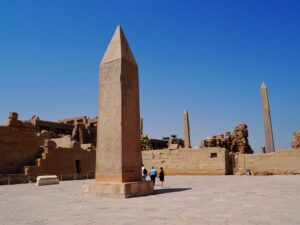
While the Pyramids receive the bulk of attention (and visitors), Upper Egypt has a tremendous amount of history, mystery and culture to offer as well. In particular, the archaeological sites in and around Luxor are truly some of the world’s best. When you’re planning your trip to see the Land of the Pharaohs, don’t forget to make time for a few days in Upper Egypt. It’s worth every minute and every effort.
Leave a Reply
You must be logged in to post a comment.